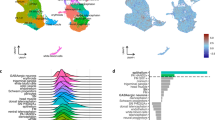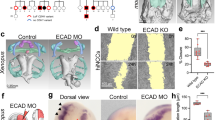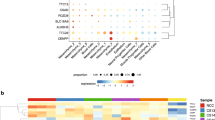Abstract
Clefts of the lip with or without cleft palate (CL/P) are one of the most common birth defects, occurring in 1/700–1/1000 infants born alive. The nature of the genetic contribution is still to be clarified; however, some chromosome regions and candidate genes have been proposed for this malformation. Recently, a couple of genes, PVR and PVRL2, mapping in the candidate region OFC3 on chromosome 19q13.31, have been investigated because of their homology to PVRL1, a gene previously shown to cause the Margarita Island CL/P-ectodermal dysplasia syndrome. In the present work, we investigated PVR and PVRL2 genes by family-based linkage disequilibrium analysis using a sample collected from the Italian population. In contrast to previous analyses on other populations, we could not find any statistically significant association between the markers alleles and non-syndromic clefting.
Similar content being viewed by others
Log in or create a free account to read this content
Gain free access to this article, as well as selected content from this journal and more on nature.com
or
References
Carinci F, Pezzetti F, Scapoli L et al: Recent developments in orofacial cleft genetics. J Craniomaxillofac Surg 2003; 14: 130–143.
Suzuki K, Hu D, Bustos T et al: Mutations of PVRL1, encoding a cell–cell adhesion molecule/herpesvirus receptor, in cleft lip/palate-ectodermal dysplasia. Nat Genet 2000; 25: 427–430.
Scapoli L, Palmieri A, Pezzetti F et al: Investigation of the W185X nonsense mutation of PVRL1gene in Italian nonsyndromic cleft lip and palate patients. Am J Med Genet 2004; 127A: 211.
Sozen MA, Suzuki K, Tolarova MM, Bustos T, Fernandez Iglesias JE, Spritz RA : Mutation of PVRL1is associated with sporadic, non-syndromic cleft lip/palate in northern Venezuela. Nat Genet 2001; 29: 141–142.
Scapoli L, Palmieri A, Martinelli M et al: Study of the PVRL1gene in Italian nonsyndromic cleft lip patients with or without cleft palate. Ann Hum Genet 2006; 70: 410–413.
Stein J, Mulliken JB, Stal S et al: Nonsyndromic cleft lip with or without cleft palate: evidence of linkage to BCL3 in 17 multigenerational families. Am J Hum Genet 1995; 57: 257–272.
Wyszynski DF, Maestri N, McIntosh I et al: Evidence for an association between markers on chromosome 19q and non-syndromic cleft lip with or without cleft palate in two groups of multiplex families. Hum Genet 1997; 99: 22–26.
Martinelli M, Scapoli L, Pezzetti F et al: Suggestive linkage between markers on chromosome 19q13.2 and nonsyndromic orofacial cleft malformation. Genomics 1998; 51: 177–181.
Warrington A, Vieira AR, Christensen K et al: Genetic evidence for the role of loci at 19q13 in cleft lip and palate. J Med Genet 2006; 43: e26.
Carinci F, Pezzetti F, Scapoli L et al: Nonsyndromic cleft lip and palate: evidence of linkage to a microsatellite marker on 6p23. Am J Hum Genet 1995; 56: 337–339.
Spielman RS, McGinnis RE, Ewens WJ : Transmission test for linkage disequilibrium: the insulin gene region and insulin-dependent diabetes mellitus (IDDM). Am J Hum Genet 1993; 52: 506–516.
Acknowledgements
This study was supported in part by grants from Telethon E. 1147 (PC), MIUR local projects (FC, FP, and PC), CARIVERONA (FC, UB, EP), Fondazione Cassa di Risparmio di Bologna (FP), and the Fondazione Cassa di Risparmio di Ferrara (FC).
Author information
Authors and Affiliations
Corresponding author
Rights and permissions
About this article
Cite this article
Pezzetti, F., Palmieri, A., Martinelli, M. et al. Linkage disequilibrium analysis of two genes mapping on OFC3: PVR and PVRL2. Eur J Hum Genet 15, 992–994 (2007). https://doi.org/10.1038/sj.ejhg.5201868
Received:
Revised:
Accepted:
Published:
Issue date:
DOI: https://doi.org/10.1038/sj.ejhg.5201868



